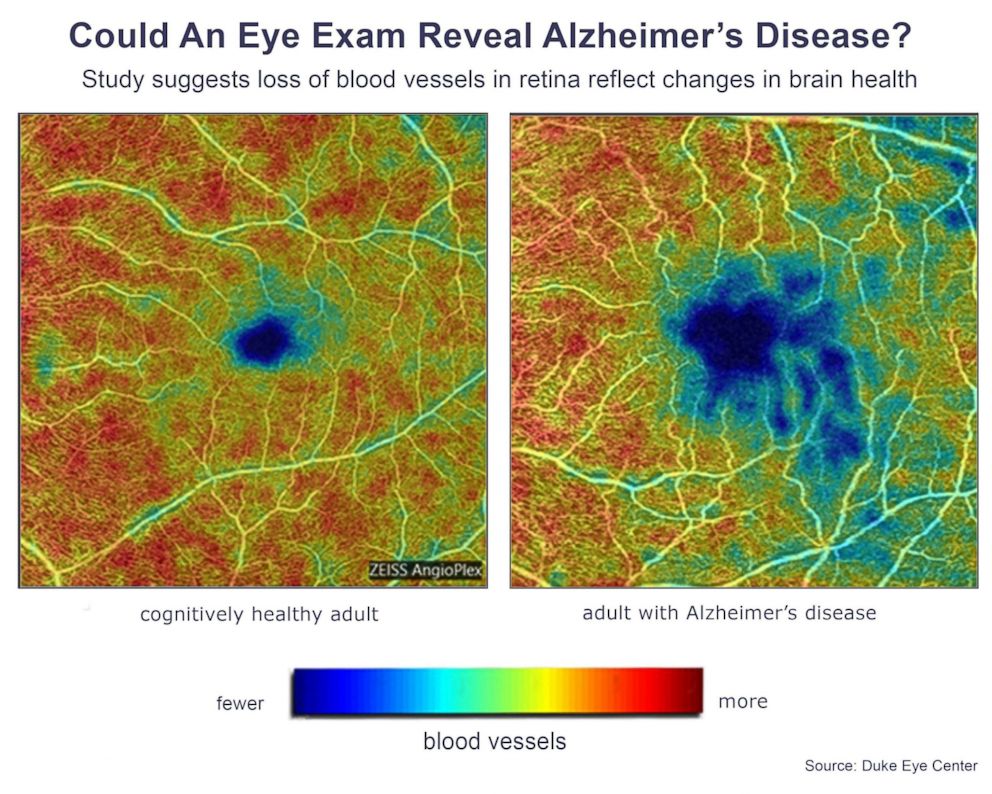New study shows eye scan can reveal changes associated with Alzheimer’s disease
Ophthalmologists at Duke University have found that a special type of eye scan can pick up changes indicative of Alzheimer’s disease. Their results were published Monday in the journal Ophthalmology Retina.
The eye scan is called optical coherence tomographic angiography, or OCTA for short. Within less than a minute, OCTA takes a non-invasive picture of the retina -- the nerve cells in the back of our eyes that convert light from the outside world into nerve signals that the brain interprets into images.
“The retina has a dense spider web of blood vessels, and we were interested in the density of these blood vessels. Like is there just one string to the spider web, or twenty?” Dr. Sharon Fekrat, an ophthalmologist and retina specialist at the Duke Eye Center in Durham, North Carolina, as well as a senior author of the study, told ABC News.
The researchers scanned the eyes of 39 people with Alzheimer’s disease, 37 people with mild cognitive impairment, which can be a precursor to Alzheimer’s, and 133 people without either of those diagnoses. They found that the density of blood vessels was less, and thickness of one particular layer of the retina was thinner among people with a known diagnosis of Alzheimer’s, compared to the other groups.

Alzheimer’s is the most common form of dementia, and affects as many as 5 million Americans, according to the Centers for Disease Control and Prevention. For every additional 5 years of age beyond 65, the number of people living with Alzheimer’s doubles. It is rarer in younger people, although they can be affected by Alzheimer’s too. And the disease is on the rise -- 14 million American expected to be diagnosed with Alzheimer’s by 2060.
An Alzheimer’s diagnosis is currently made based on clinical history and cognitive testing, without relying on imaging studies or blood tests. Having a diagnostic aid like OCTA could potentially help with making an earlier diagnosis.
Dr. Fekrat believes that if more people in the earlier stages of Alzheimer’s could be recruited into clinical trials, there is a bigger potential for better treatments to be discovered. Similar findings were discovered in 2018. In that smaller study, performed at the University of Miami, OCTA also identified fewer numbers of small blood vessels in the eyes of people with Alzheimer’s.
So why may there be poor blood supply to the eyes of people with Alzheimer’s?
The new study’s authors propose reduced blood flow to the eyes may be because the protein that signals blood vessels to grow and proliferate is found at low levels in people with Alzheimer’s. It may get trapped in the deposits of another protein called amyloid that is commonly associated with in the disease.
One of the limitations of the new study is that 22 percent of the Alzheimer’s group studied was unable to complete the imaging study because of inability to focus long enough for its completion. OCTA is also not routinely available in eye doctor’s offices across the country.
“It can’t be used to diagnose Alzheimer’s disease quite yet. It will be many years before it goes into prime time,” Dr. Fekrat said. “We need to validate the study in larger groups of patients, and follow these patients with time.”
Dr. Leila Haghighat is an internal medicine resident from Yale New Haven Hospital who also works with the ABC News Medical Unit.




